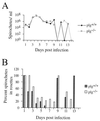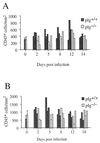Delayed invasion of the kidney and brain by Borrelia crocidurae in plasminogen-deficient mice
- PMID: 11500461
- PMCID: PMC98701
- DOI: 10.1128/IAI.69.9.5832-5839.2001
Delayed invasion of the kidney and brain by Borrelia crocidurae in plasminogen-deficient mice
Abstract
Borrelia crocidurae is an etiologic agent of relapsing fever in Africa and is transmitted to humans by the bite of soft ticks of the genus Ornithodoros. The role of the plasminogen (Plg) activation system for the pathogenicity of B. crocidurae was investigated by infection of Plg-deficient (plg(-/-)) and Plg wild-type (plg(+/+)) mice. No differences in spirochetemia were observed between the plg(-/-) and plg(+/+) mice. However, signs indicative of brain invasion, such as neurological symptoms and/or histopathological changes, were more common in plg(+/+) mice. Quantitative immunohistochemical analysis demonstrated infection of spirochetes in kidney interstitium and brain as soon as 2 days postinoculation. Lower numbers of extravascular spirochetes in plg(-/-) mice during the first days of infection suggested a less efficient invasion mechanism in these mice than in the plg(+/+) mice. The invasion of the kidneys in plg(-/-) mice produced no significant inflammation, as seen by quantitative immunohistochemistry of the CD45 common leukocyte marker. However, significant kidney inflammation was observed with infection in the plg(+/+) mice. In brain, inflammation was more severe in plg(+/+) mice than in plg(-/-) mice, and the numbers of CD45(+) cells increased significantly with duration of infection in the plg(+/+) mice. The results show that invasion of brain and kidney occurs as early as 2 days after inoculation. Also, Plg is not required for establishment of spirochetemia by the organism, whereas it is involved in the invasion of organs.
Figures






Similar articles
-
The plasminogen activation system enhances brain and heart invasion in murine relapsing fever borreliosis.J Clin Invest. 1999 Jan;103(1):81-7. doi: 10.1172/JCI5171. J Clin Invest. 1999. PMID: 9884337 Free PMC article.
-
Erythrocyte-aggregating relapsing fever spirochete Borrelia crocidurae induces formation of microemboli.J Infect Dis. 1999 Dec;180(6):1929-38. doi: 10.1086/315118. J Infect Dis. 1999. PMID: 10558950
-
The spirochete Borrelia crocidurae causes erythrocyte rosetting during relapsing fever.Infect Immun. 1998 Feb;66(2):815-9. doi: 10.1128/IAI.66.2.815-819.1998. Infect Immun. 1998. PMID: 9453646 Free PMC article.
-
Borrelia pathogenesis research in the post-genomic and post-vaccine era.Curr Opin Microbiol. 2000 Feb;3(1):86-92. doi: 10.1016/s1369-5274(99)00056-9. Curr Opin Microbiol. 2000. PMID: 10679423 Review.
-
Borrelia infection in small mammals in West Africa and its relationship with tick occurrence inside burrows.Acta Trop. 2015 Dec;152:131-140. doi: 10.1016/j.actatropica.2015.08.016. Epub 2015 Sep 19. Acta Trop. 2015. PMID: 26327444 Review.
Cited by
-
Characteristics of Borrelia hermsii infection in human hematopoietic stem cell-engrafted mice mirror those of human relapsing fever.Proc Natl Acad Sci U S A. 2011 Dec 20;108(51):20707-12. doi: 10.1073/pnas.1108776109. Epub 2011 Dec 5. Proc Natl Acad Sci U S A. 2011. PMID: 22143787 Free PMC article.
-
In vitro identification of novel plasminogen-binding receptors of the pathogen Leptospira interrogans.PLoS One. 2010 Jun 22;5(6):e11259. doi: 10.1371/journal.pone.0011259. PLoS One. 2010. PMID: 20582320 Free PMC article.
-
Understanding tropism and immunopathological mechanisms of relapsing fever spirochaetes.Clin Microbiol Infect. 2009 May;15(5):415-21. doi: 10.1111/j.1469-0691.2009.02785.x. Clin Microbiol Infect. 2009. PMID: 19489924 Free PMC article. Review.
-
The HtrA protease of Borrelia burgdorferi degrades outer membrane protein BmpD and chemotaxis phosphatase CheX.Mol Microbiol. 2013 May;88(3):619-33. doi: 10.1111/mmi.12213. Epub 2013 Apr 9. Mol Microbiol. 2013. PMID: 23565798 Free PMC article.
-
Borrelia burgdorferi Surface Exposed GroEL Is a Multifunctional Protein.Pathogens. 2021 Feb 18;10(2):226. doi: 10.3390/pathogens10020226. Pathogens. 2021. PMID: 33670728 Free PMC article.
References
-
- Anda P, Sánchez-Yebra W, del Mar Vitutia M, Perez Pastrana E, Rodríguez I, Miller N S, Backenson P B, Benach J L. A new Borrelia species isolated from patients with relapsing fever in Spain. Lancet. 1996;348:162–165. - PubMed
-
- Aubry P, Renambot J, Teyssier J, Buisson Y, Granic G, Brunetti G, Dano P, Bauer P. Borreliosis caused by ticks in Senegal; apropos of 23 cases. Dakar Med. 1983;28:413–420. - PubMed
-
- Bergeret C, Raoults A. Notes sur les formes nerveuses de la fievre recurrente—fievre recurrente a tiques en Afrique Occidentale Francaise. Bull Med Afr Occidentale Fr. 1948;5:271–279.
Publication types
MeSH terms
Substances
LinkOut - more resources
Full Text Sources
Molecular Biology Databases
Research Materials
Miscellaneous

